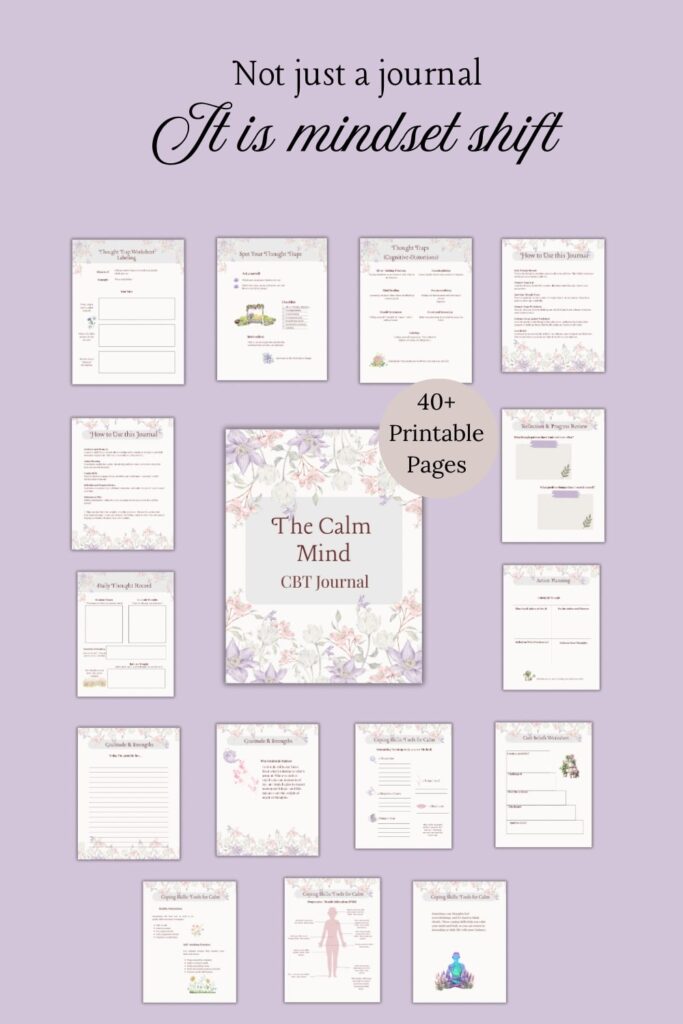
A few months ago, I realized my thoughts were running my day.
One small mistake could send me into hours of self-criticism and anxiety.
Then I discovered CBT journaling — a simple, science-based way to understand and challenge those thoughts instead of believing them. What started as a few minutes of writing each day turned into one of the most healing habits I’ve ever built.
Cognitive Behavioral Therapy (CBT) helps you recognize your thinking patterns and gently shift them toward something calmer and more balanced.
One of the easiest ways to practice this on your own is using CBT journaling prompts to explore what you think, feel, and believe.
Over time, you’ll start to notice patterns, challenge unhelpful thoughts, and create more peace in your inner world.
I designed The Calm Mind CBT Journal to make this process simple and approachable — even on stressful days.

In this post, you’ll find 30 CBT journal prompts you can start with, plus a look at how this type of journaling actually works.
Table of Contents
What Are CBT Journal Prompts?
CBT journal prompts are short, focused questions that help you see how your thoughts influence your emotions and behavior.
They’re not about forcing positivity — they’re about noticing your automatic thoughts and gently asking, “Is this completely true?”
By answering CBT prompts regularly, you learn to slow down your reactions and respond with more clarity.
It gives your mind a moment to pause before it spirals.

A free Sample of CBT Journal Template is included ⬆️
How CBT Journal Prompts Work (The 5-Step Thought Process)
Each CBT exercise follows a simple but powerful five-step reflection.
It helps you slow down, notice what’s happening in your mind, and shift your perspective with more compassion.
This is the same reflection flow I follow in The Calm Mind CBT Journal:
- Situation: What happened?
Start by describing the situation that triggered your thoughts or emotions. Keep it factual — who was involved, what was said, what event took place.
This helps you separate what actually happened from the story your mind might be telling around it. - Thoughts: What went through your mind?
Write down your first automatic thoughts — even if they sound harsh, irrational, or embarrassing. Seeing them on paper helps you recognize patterns you might otherwise miss. - Emotions: What did you feel in that moment?
Label your emotions clearly. Were you anxious, hurt, angry, or disappointed?
Naming emotions creates space between you and the feeling — allowing you to respond instead of react. - Evidence For / Against: What facts support or challenge that thought?
Take a closer look. Ask: Is this thought 100% true?
Look for facts that support your thought, and then find facts that contradict it. This trains your mind to think more critically and fairly. - New Belief / Reframe: What’s a calmer, more balanced way to view it?
Rewrite the thought in a way that feels realistic and kind.
It’s not about false positivity — it’s about finding a healthier middle ground.
For example: instead of “I always mess things up,” try “I made a mistake, but I can learn and do better next time.”

This gentle process turns emotional overwhelm into understanding.
Instead of reacting automatically, you start noticing why you feel what you feel — and that’s where real change begins.
30 CBT Journaling Prompts to Try Today
Use these prompts daily, or pick one whenever your mind feels cluttered.
They’ll guide you through identifying, questioning, and reframing your thoughts.

- What thought has been replaying in my mind today?
- What emotion does this thought bring up for me?
- What evidence supports this thought?
- What evidence challenges it?
- If my best friend thought this way, what would I tell them?
- What’s one alternative explanation for what happened?
- How would I view this if I were feeling calm and confident?
- What need or fear might be hiding behind this thought?
- What triggered this reaction?
- What emotion do I notice in my body right now?
- What’s something I can’t control here — and something I can?
- What pattern do I keep repeating in similar situations?
- What story am I telling myself about this?
- What’s the kindest way I could reframe this situation?
- How might this thought be protecting me in some way?
- What’s one fact I might be overlooking?
- What emotion do I find hardest to sit with?
- What small action could help me feel safer or calmer right now?
- What would change if I believed this thought wasn’t true?
- When was the last time I felt in control — what was different then?
- What is this situation teaching me about myself?
- How would I describe this moment without judgment?
- What does my inner critic sound like?
- What evidence do I have that I’ve handled things well before?
- What outcome am I afraid of, and how likely is it really?
- What am I grateful for, even in this challenge?
- How can I show compassion to myself right now?
- What belief about myself do I want to strengthen instead?
- What can I do differently next time to stay calm?
- What truth feels more empowering than the one I started with?
Why CBT Journaling Matters for Your Mind
Our thoughts shape how we experience the world — and many of them run on autopilot.
CBT journaling helps you slow those thoughts down long enough to understand them.
By writing things out, you begin to separate facts from feelings, and truth from assumptions. This simple act creates space — space to respond with clarity instead of reacting out of habit.
CBT journaling builds self-awareness, emotional balance, and resilience. It trains your mind to question unhelpful thoughts and replace them with ones that feel more grounded and compassionate.
It’s not about perfection or positivity all the time — it’s about understanding yourself better, one page at a time.

A free Sample of CBT Journal Template is included ⬆️
How to Make CBT Journaling a Daily Habit
You don’t need hours to benefit from CBT journaling — just five to ten quiet minutes a day can make a real difference.
Think of it as a small daily check-in with your thoughts and emotions, a pause that helps you stay grounded before life pulls you in a hundred directions.
Try to write at the same time each day — consistency helps your mind recognize that this is your space to breathe.
Morning: Use your journal to set a calm, balanced mindset before your day begins. Reflect on any worries and reframe them early so you can start fresh.
Evening: Before bed, take a few moments to unpack your emotions and release the day’s mental clutter. You’ll rest easier when your thoughts are on paper, not in your head.
If you ever feel too tired or unsure what to write, a guided layout can help.
That’s why I designed The Calm Mind CBT Journal with gentle prompts and clear sections — to make reflection simple and comforting, even on hard days.

You don’t need perfect words — just the intention to show up. Over time, those few minutes of honesty will lead to something beautiful: a calmer, clearer version of you.
Final Thoughts on Using CBT Journaling Prompts
You don’t have to change your whole mindset overnight — real growth starts with one small reflection at a time. Even a single page of CBT journaling each day can help you feel calmer, clearer, and more in control of your thoughts.
So the next time you feel overwhelmed or caught in a spiral of “what-ifs,” pause. Write it down. Follow the five-step flow, and notice how much lighter your mind feels once your thoughts are out on paper.

If you want a simple, structured way to begin, try using The Calm Mind – CBT Planner. It’s filled with guided prompts and thoughtful sections to help you reflect daily — without the pressure to be perfect.
Your calm mind is already within reach — all you need is a few quiet minutes and a pen
Love and Light,








Leave a Reply